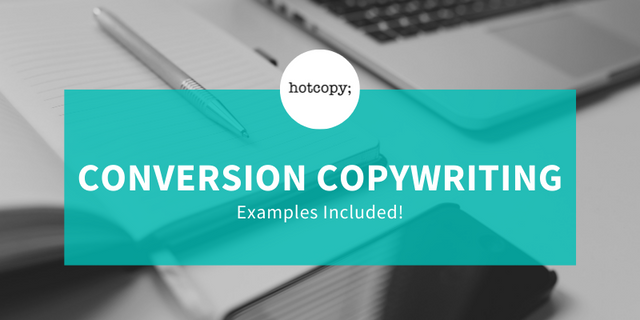Conversion Copywriting Explained: Examples Included!

Good copywriting is key if you want your business, marketing campaign, or even blog to grow. That’s a no-brainer. But good copy doesn’t necessarily mean more sales or a higher reach. That’s where conversion copywriting comes in.
Let’s start by answering the question, what is a conversion?
A conversion is whatever goal you’ve set for your content. Here are some examples:
- Increasing the number of subscribers to your lifestyle blog
- Boosting the number of downloads for your e-book
- Getting new customers to sign up for a product trial
- Improving sales for your life mastery seminar
- Having more people book appointments to test your product
Conversion copywriting is focused on doing one thing: Help you reach your content goals.
In this article, we will run through some examples of effective high-converting copy and also point out some tips and tricks that digital content marketers in Malaysia use to achieve all their business goals.
Call-to-Action
Before you even attempt to write (or hire someone to write) a conversion copy, you need to do some soul-searching. Identify the goals you want your content to achieve because that will help you determine your call-to-action keywords, a.k.a your Search Engine Optimization.
SEO is becoming a congested market. Having a firm grasp on your high-value keywords will make your SEO content creation journey much easier and definitely more effective.
1. Consider the length
Your call-to-action does not have to be long. Just like the long copy versus short copy argument, both forms have their own merits. Movie and series streaming site Netflix has a clear, short, and sweet call-to-action.

Image Source: Netflix website landing page
The few short lines of copy highlight the benefit of the service (100% entertainment), low cost of entry (RM0.01 for your first 100 days), and a box clearly marked for your email address.
The content is straightforward, easy to understand, and achieves Netflix’s goal of gaining new subscribers with an easy entry option.
2. Consider the function
Vehicle subscription service provider Flux is a good example of the diverse functions of a call-to-action.

Image Source: Flux website landing page
Instead of pushing target customers to “Try it now!” or “Book an appointment!”, Flux encourages visitors to its site to check out its inventory first. This business requires a slightly higher financial commitment from its customers, which is why a low-pressure entry is more effective.
This illustrates the importance of being clear about the direction of your business or venture. You need to write down the goals you want to achieve with every piece of copy that carries your name or your company’s name. This includes every website page, Facebook ad, Instagram caption, blog post, and email blast.
You can only reap the full rewards of conversion writing if you are clear about what you want to achieve AND can translate that into a powerful call-to-action.
3. Consider the USP (Unique Selling Point)
Effective conversion copywriting entices potential clients to engage with your call-to-action button, which will expose them to your unique selling point. In Flux’s case, it is “better than buying or leasing a car.” For Adobe, it’s their Creative Cloud.

Image Source: Adobe website landing page
Adobe has a very strong and clear idea about the benefits they provide and which keywords to use to entice new users. Note that the word “create” is used twice in the short copy.
Research
High-converting copy steps beyond creative copy in that it is rooted in statistics and data. If you want to hit your conversion goals, you’ll need to do some research. Start with your target audience and be specific!
For conversion copywriting to work, you need to convey your message with clarity and precision. Make an effort to identify your primary and secondary audience, their demographics, pain points, information sources, role in the family, and more.
The more information you have, the easier it will be to hit your goals.
4. Find your target audience
Use professional services like Google Analytics or hire market research companies to take the guesswork out of this process. You can also look up existing market research or choose to conduct your own surveys to verify the data you’ve found.
Insurance provider Prudential is an example of how you can use market research and effective copywriting to attract customers.

Image Source: Prudential website landing page
This campaign focuses on the unexpected happening to people who are relatable – a heart attack in your 30s, head of a family diagnosed with cancer, and a fresh graduate suffering a spinal injury.
You need to find out specifically who your target audience is and what they want, need, and expect from your product or service. A conversion can only happen if you manage to persuade them that you can provide the result they are after.
5. Find your competitors
Now that you know who your target audience is, it’s time to look into your competitors. Find out what they promise their clients, what their call-to-actions are, and most importantly, what their conversion copywriting looks like.
“Wait, isn’t that cheating?” you might wonder. No, it isn’t. This is actually a very important step in refining your result-driven content because you need to know how to set yourself apart.
When conducting a competitor audit, make sure you answer these questions:
- What problem do they claim they are solving?
- How do they set themselves apart from the competition?
- What convincing proof do they provide about their service/product?
Contrary to popular advice, you don’t have to be completely different from your competition. Take onboard what works and improve on what doesn’t.
Here is the landing page for the zero-waste store - The Hive.

Image Source: The Hive website landing page
It sets itself apart by claiming to be “Most Preferred by Zero Wasters” while also working high-value keywords into the copy.
Put it all together
By now, you should have answered all these questions:
- Who is your target audience?
- What do they want, need, and expect from you?
- What are your content/business goals?
- What sets you apart from your competitors?
- What are your call-to-action keywords?
If you know all the answers to the above, then you’re well on your way to creating a high-converting copy.
Our parting tips to you are all about how to improve the potency of your conversion content. Leverage on psychology!
- Using the right color on your call-to-action button can speed up the clicks.
- Be clear and concise about your offering! If it’s free, say so.
- Use numbers to indicate scarcity and improve motivation.
Conversion copywriting is about using the right words to persuade your target audience that you are the right choice for them.
A lot of work goes into it, but Hotcopy is here to help! Use our hotcopy; AI content platform to upgrade your copywriting.
Photo by Negative Space on Pexels
Want to save time and money on the content for your brand?
Try our hotcopy; AI platform to optimize your content production workflow today.
The first few words are free for you to try.


